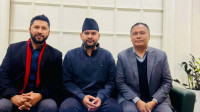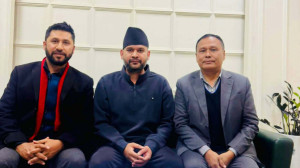Politics
Ruling party debates directly elected executive head once again. This time, it has the numbers
With many central members in favour of a directly elected head, the party could get the motion passed in Parliament as it has a two-thirds majority.
Tika R Pradhan
The ruling Nepal Communist Party is once again considering the merits of transitioning to an electoral system with a directly elected executive head, after laying the debate to rest during the drafting of the 2015 constitution.
At the concluding session of the party’s Central Committee meeting on Sunday, co-chair Pushpa Kamal Dahal said that the next meeting of the Central Committee, scheduled to take place within the next six months, will thoroughly discuss electoral and governance systems after consulting with experts.
Though the issue of the electoral and governance systems was not on the agenda of the meeting, it came up when leaders discussed ways to curb corruption. During the ensuing discussion, many Central Committee members stood in favour of a directly elected executive head on the grounds that the current electoral system—a combination of first-past-the-post and proportional representation—was becoming a major cause of corruption. According to leaders, candidates have to spend large sums of money in order to win the election.
“Many leaders were in favour of a directly elected executive head and ministers appointed from among experts instead of lawmakers,” said Hemraj Bhandari, a central member. “This could help reduce electoral corruption.”
During the discussion, party members floated different ideas to reduce spending during elections. One was for a fully proportional system, instead of the existing dual electoral system, where only the parties contest elections for the legislature. If the proportional representation system is adopted, the country will need a directly elected executive head who will choose ministers from among experts instead of lawmakers.
“If a lawmaker cannot become minister, there won’t be unhealthy competition to contest and win elections,” said Bhandari.
Instead of many leaders vying for the first-past-the-post elections, one candidate from each party will fight for the executive leadership—whether the prime minister or president—with all others elected through proportional representation.
“We are in favour of a directly elected executive head at the three levels of government—federal, provincial and local,” said Devendra Poudel, a Standing Committee member.
Before the promulgation of the 2015 constitution, the then CPN-UML was in favour of a directly elected prime minister while the CPN (Maoist Centre) advocated a directly elected president. But differences were settled via a 16-point deal, under which the parties agreed to continue with the existing system with a prime minister elected by Parliament and a ceremonial president. The Maoist party led by Dahal had registered a note of dissent on provisions related to the forms of government in the new constitution.
Political analysts, however, say that the country is not ready to change systems so soon into federalism.
“The new provisions in the constitution, including limiting the Cabinet to 25 members and restricting the motion of no-confidence for two years, were praiseworthy,” said Khimlal Devkota, a fiscal federalisation and local government analyst. “We can make some improvements within the existing set-up, but drastic changes may invite unwanted consequences.”
But party members are adamant that a change is necessary in order to allow “honest leaders” to contest elections fairly.
“This election system has not only crippled the parties but also our system,” said Dilu Panta, a central member.
With an almost two-thirds majority in Parliament, the Nepal Communist Party (NCP) could get Parliament to amend the constitution to ensure a change in the electoral and governance systems. Both Samajbadi Party Nepal and Rastriya Janata Party, Nepal have been in favour of a directly elected executive.
“If the ruling party, which has a two-thirds majority in both houses of the federal parliament, decides unanimously, it won’t need the support of any other party to amend the constitution,” said Pandey.
The Samajbadi Party has long been lobbying for a directly elected executive head and Rastriya Janata Party leaders also said they could go for it.
“Currently, we are for the Westminster model but if all parties including the ruling party and Samajbadi Party go for a directly elected head, our party will also go along,” said Keshav Jha, general secretary of the Janata Party.
The Upendra Yadav-led Madhesi Janadhikar Forum had contested the 2007 Constituent Assembly on an agenda of directly elected president and a fully proportional electoral system.
“As the saying goes, a pill for all ills—directly elected President/PM system is the cure for all ills of the country—expensive polls, corruption, crony capitalism, political horse-trading, danger of instability, irresponsible bureaucracy, parties’ syndicate etc. Let’s develop a national consensus on this! Or else,” Baburam Bhattarai, chairman of the Samajbadi Party, tweeted on Monday.
Only the Nepali Congress, the principal opposition, is standing in the way. The party staunchly opposes a directly elected head, but it lacks the numbers to mount a formal challenge.
“The Nepali Congress will stay away from this idea because this system will lead already autocratic communist rulers to a more authoritarian rule,” said Ramesh Lekhak, a central member of the Nepali Congress. “I knew this long ago. This move will end democracy in the country.”




 12.12°C Kathmandu
12.12°C Kathmandu













%20(1).jpg&w=300&height=200)

